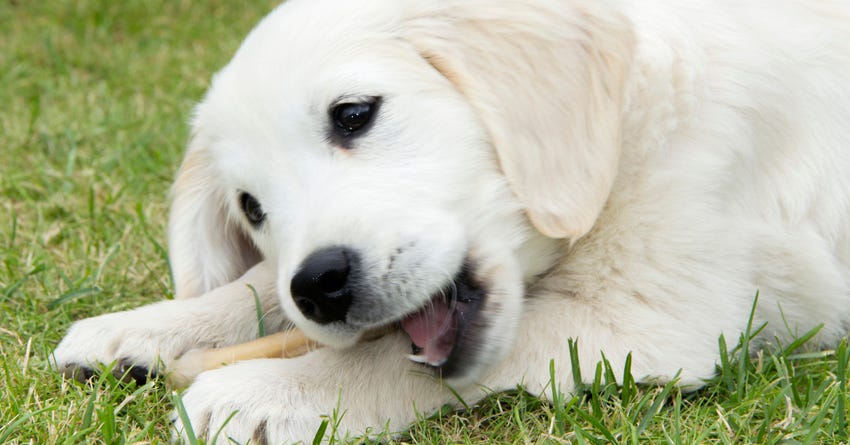The Puppy teething period, despite not lasting very long, often requires giving your pup some additional attention to keep them comfortable and occupied.
The following guide is intended to help new puppy owners understand what they might see, when they might experience it, and some helpful tips to make your pup more comfortable (and hopefully prevent you from losing any valuable shoes or housing items to chewing).
A Helpful Puppy Teething Timeline: How Long Will It Last?
The puppy teething stage generally lasts 3 - 5 months and is different for every individual puppy. You’ll want to begin watching a dog for the signs of teething in month 3 of their life until about month 8.

Puppy Teeth Come in At 6 to 8 Weeks Old
Your puppy's first baby teeth, also called deciduous teeth, come in between six and eight weeks of age.
Since this happens before you bring him home, you won't have to deal with this. However, those baby teeth only last a few months before his adult teeth break through the gums. This can cause as many problems for your puppy as it does for human children when they're teething. It's a tough time for both the puppy and her owners.
Puppies Lose Their Incisors (Front Teeth) In Month 3
Puppies will begin losing baby teeth and growing their adult teeth at an individual rate.
However, most puppies begin losing their incisors (those tiny teeth at the front of the mouth) during the puppy’s third month, often towards the end of the third month. These lost incisors will let you know teething has started.
Puppies Will Continue to Lose Back Teeth From Months 4 to 8
The teething then moves from front to back. The canine teeth (the fangs) usually fall out next, followed by the premolars and then molars. However, it’s not unusual for the fangs to remain as the premolars fall out. Between six to eight months, your puppy should have all 42 adult teeth.
Common Sign and Symptoms of Puppy Teething
While every pup is different, there are several common signs that your puppy might be at the phase in which he or she will be growing adult teeth soon. Below is a helpful list to be aware of:
- Finding spots of blood on their toys
- Literally finding tiny puppy teeth around the house
- More than usual desire to chew everything
- Increased drooling
- Changing in pace of eating (slowing down)
- Red and swollen gums
- Sometimes running a low-grade fever
- Whining
- Soft stools
- Upset stomach
5 Tips and Tricks To Help a Teething Puppy
1) Replace Your Finger And Your Beloved Items With Dog Toys
Yes, nipping is annoying and can hurt, but don’t take it personally, because all puppies do this. Keep this tip in mind: when your puppy starts to nip you or something they shouldn’t, replace it with a toy instead. As long as he has something to chew on, he won’t care! This will start to teach your pup what is okay to chew on and what is not.
If the nipping becomes too much for you, remove him from the situation for a few moments. Put them somewhere safe and quiet until everyone calms down. Never yell or lash out at him for nipping. Your puppy needs your patient support to get through this time.
2) Wet Food Will Feel Better On Sore Puppy Mouths
How can you eat properly if your teeth are hurting? Your puppy may turn his nose up at his food bowl or be hesitant to eat, not because he isn’t hungry, but because eating is painful. Try wet dog foods, or even just try adding some water to his dry food so that it softens. You’ll notice that he’ll eat his food with much more gusto.
The Honest Kitchen has several wet foods that dogs enjoy:
3) Freeze A Puppy’s Toys and Food
While teething, your puppy’s gums will swell and cause him pain. To ease the pain, soak a rope toy in water and then freeze it. You can also freeze a Kong filled with peanut butter. These frozen toys will help reduce your pup’s swelling and pain.
4) Pick Safe, Durable Chews and Toys
During this teething time, you can’t go without chewing toys for your puppy. Avoid artificially dyed products and rawhide chews (here are some useful alternatives to rawhides). Stay natural with Bully sticks, chew hooves, bones, and antlers. For safety purposes, always supervise your puppy while he’s chewing.
5) Get Your Puppy Used To You Inspecting His or Her Teeth Early
Make sure to routinely check your puppy’s mouth to see how those teeth are coming along. Teething can take weeks or months, so look into his mouth regularly to stay on top of problems.
Start early getting your puppy used to you having your fingers in his mouth, because if you get him used to this process before teething starts, then he’ll be more okay with you doing it when his mouth is uncomfortable.
Recommended Reading:
Retained Puppy Teeth
When your puppy goes to the veterinarian's clinic for vaccinations, the veterinarian will check your puppy's mouth to see how teething is progressing. However, check your puppy's mouth regularly in between these appointments and if you see a retained baby tooth with an adult tooth growing in beside it, give your vet a call to see if she wants to see your puppy right away. A retained baby tooth can cause damage to the permanent tooth. If the baby tooth isn't pulled in a timely manner, the adult tooth could grow in crooked, causing it to be in an incorrect position in the puppy's mouth. This could cause him difficulty eating, pain in his mouth, and a variety of other problems.
Need More Helpful Puppy Information?
From nutrition to teething, we’ve got articles to help you and your new friend stay happy and healthy. Feel free to check out some of these articles that we think you’ll also enjoy:
- The Best Way To Potty Train a Puppy
- Understanding the Nutritional Needs of Puppies
- When Age Should Puppies Go to Their New Home?

